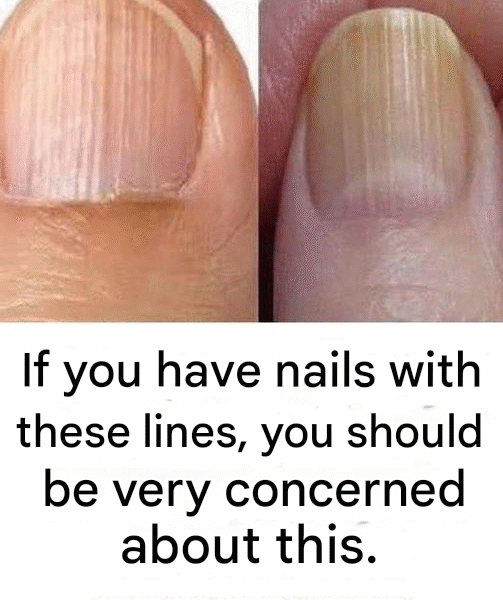If You Have These Lines on Your Nails, You Should Be Concerned
Our nails can tell us a lot about our health. They are not just a cosmetic feature but also serve as indicators of our overall well-being. Small changes or abnormalities in the appearance of your nails can sometimes be signs of underlying health issues. One common yet often overlooked nail abnormality is the appearance of lines on your nails. These lines can vary in color, depth, and texture, and while some may be harmless, others could signal a more serious health concern. In this article, we will explore the different types of lines that may appear on your nails and what they could mean for your health.
Types of Lines on Nails and What They Mean
- Horizontal Ridges (Beau’s Lines)
Beau’s lines are deep, horizontal grooves that run across the nails. These lines can appear suddenly and are often a sign that something is affecting the body’s ability to produce new nail cells. Beau’s lines can be caused by a variety of factors, including:- Infections: Serious illnesses such as scarlet fever, pneumonia, or a high fever can interrupt nail growth, leading to these horizontal ridges.
- Nutrient Deficiencies: A deficiency in essential nutrients like zinc, biotin, or protein can affect nail health, causing Beau’s lines to appear.
- Trauma or Injury: Physical trauma to the nail matrix can lead to temporary Beau’s lines.
- Chronic Conditions: Conditions such as diabetes, heart disease, or autoimmune diseases can result in Beau’s lines, as they may disrupt normal nail growth.
- Vertical Ridges (Longitudinal Ridges)
Vertical ridges, also known as longitudinal ridges, run from the tip of the nail to the base. These ridges are often more common in older adults and can be a sign of aging. However, they may also indicate:- Dehydration: Lack of moisture can lead to the development of vertical ridges. This is especially common in people who do not maintain a proper skincare routine for their hands and nails.
- Nutrient Deficiencies: Similar to Beau’s lines, vertical ridges can be a sign of a vitamin deficiency, particularly a lack of biotin, iron, or vitamin B12.
- Thyroid Problems: Issues with the thyroid, such as hypothyroidism or hyperthyroidism, can also cause vertical ridges to appear on the nails.
- White Spots (Leukonychia)
White spots on the nails are one of the most common nail issues, and while they are typically benign, they can be a cause for concern in certain cases. These spots are usually small, white discolorations on the surface of the nail and can be caused by:- Injury or Trauma: Minor trauma to the nail bed can cause small white spots to appear.
- Nutrient Deficiencies: Zinc or calcium deficiencies can lead to white spots on the nails.
- Fungal Infections: In some cases, fungal infections can cause the appearance of white spots, especially if the infection is severe.
- Dark Lines (Subungual Hemorrhage)
Dark, vertical lines that appear under the nail plate are often a sign of a subungual hemorrhage, which is bleeding underneath the nail. These lines are usually caused by:- Trauma or Injury: A bump or hit to the nail can cause blood vessels under the nail to break, leading to dark streaks or spots.
- Fungal Infections: In some cases, dark lines may indicate a fungal infection under the nail.
- Health Conditions: In rare cases, dark lines under the nails can indicate a more serious condition such as melanoma, a type of skin cancer. It is essential to seek medical attention if you notice dark streaks, especially if they are irregular, change over time, or are accompanied by other signs like pain or swelling.
- Clubbed Nails
Clubbed nails, where the tips of the fingers swell and the nails curve downward, can sometimes be associated with serious health conditions, including:- Heart Disease: Clubbed nails can be a sign of heart-related issues, especially those affecting oxygen levels in the blood.
- Lung Disease: Chronic lung diseases, such as COPD or lung cancer, can also lead to clubbed nails.
- Liver Disease: Conditions such as cirrhosis or hepatitis may cause the nails to become clubbed as well.
What You Can Do About It
If you notice any of these lines on your nails, it’s important not to ignore them. Here are some steps you can take to address the issue:
- Consult a Healthcare Provider: If you notice significant changes in your nails, particularly if they are accompanied by other symptoms, it’s essential to seek medical advice. A healthcare provider can help determine the underlying cause and recommend appropriate treatment.
- Maintain a Healthy Diet: Ensure you’re eating a well-balanced diet rich in vitamins and minerals, including zinc, biotin, iron, and vitamin B12. A nutritious diet can support overall nail health.
- Practice Good Nail Care: Regularly moisturize your nails and hands to prevent dryness and cracking. Avoid harsh chemicals or trauma to the nails that could lead to abnormalities.
- Keep an Eye on Changes: If you notice any new lines or changes to your nails, monitor them over time. If they persist or worsen, seek medical attention for a more thorough evaluation.
Final Thoughts
Your nails can reveal a lot about your health. Lines and abnormalities that appear on your nails can sometimes indicate underlying health problems. It’s important to stay vigilant and seek professional advice if you notice changes in your nails, especially if they are accompanied by other symptoms. Remember, early detection and intervention can make a big difference in addressing health concerns.
If you found this information helpful, please share this post with your friends and family, and don’t forget to like it for more health tips!
